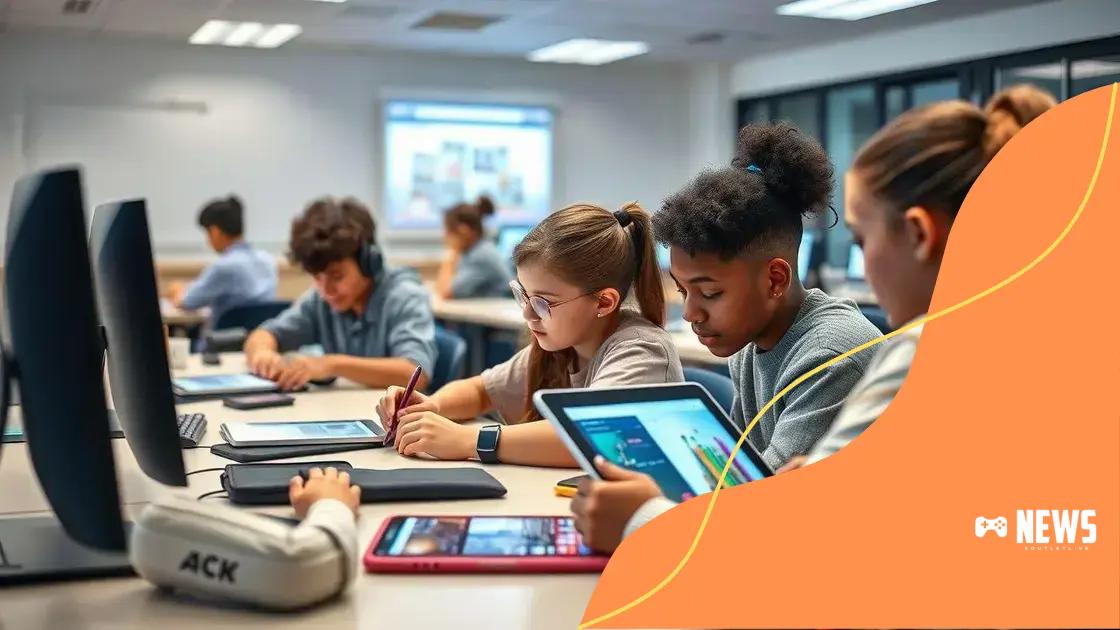Plans to stop dropouts early: effective strategies

Plans to stop dropouts early involve identifying at-risk students, implementing innovative support programs, leveraging technology, and fostering strong parent-school partnerships to enhance student engagement and success.
Plans to stop dropouts early are crucial for ensuring students thrive academically. By addressing potential issues before they escalate, schools can create a supportive environment that fosters learning and retention. Let’s explore practical strategies that can make a real difference.
Identifying at-risk students early
Identifying at-risk students early is essential for creating effective plans to stop dropouts early. By recognizing signs of struggle early, educators can provide the support needed to keep students engaged and thriving. Early interventions can change the trajectory of a student’s education.
Signs of At-Risk Behavior
Numerous factors can signal that a student may be at risk of dropping out. Educators and staff should be trained to look beyond grades and attendance.
- Poor academic performance: Low grades in key subjects often indicate that a student is struggling.
- Frequent absences: Missing school can lead to disconnect and further decline in performance.
- Behavioral changes: Sudden changes in behavior or attitude may signal personal issues.
- Withdrawal from activities: Students who disengage from school activities may be feeling lost.
Addressing these signs promptly is crucial. Schools can implement regular check-ins, mentorship programs, and even peer support groups to foster a sense of belonging.
Additionally, schools can use data analysis to spot trends. By collecting and analyzing data on attendance, grades, and behavior, educators can pinpoint students who may need extra support.
Collaboration with Families
Engaging families is another effective strategy. When schools communicate with parents about their child’s progress, it creates a stronger support system. A proactive approach can help families understand the importance of their involvement in their child’s education.
When educators work together with families, they create a network of support. This collaboration can include home visits, workshops, and regular progress reports. Such efforts ensure that parents are informed and can participate in their child’s learning journey.
Overall, identifying at-risk students early is not just about recognizing problems; it’s about building a pathway to success through targeted support and community involvement.
Innovative support programs
Innovative support programs play a vital role in plans to stop dropouts early. These programs aim to engage students actively, providing the resources they need to succeed. By addressing challenges head-on, schools can foster a nurturing environment.
Types of Innovative Support Programs
Many schools have adopted unique strategies to assist at-risk students. From mentoring to technology integration, these programs are tailored to meet diverse needs.
- Mentorship initiatives: Pairing students with mentors helps develop essential relationships and guidance.
- After-school tutoring: Providing extra academic support outside regular hours keeps struggling students on track.
- Social-emotional learning programs: Programs focused on mental wellness teach valuable coping skills and resilience.
- Online learning resources: Leveraging technology gives students flexibility in their studies and learning styles.
These types of programs can be transformative. For instance, mentorship initiatives create strong bonds and provide students with role models they can relate to. Additionally, after-school tutoring offers personalized help that may be more effective than standard classroom learning.
Moreover, focusing on social-emotional learning equips students with essential life skills. This holistic approach addresses not just academic needs but also emotional health, which can contribute to their overall success.
Collaborative Approaches
Collaboration is key in executing these innovative support programs. Schools can partner with local organizations, businesses, and community leaders to enhance their offerings. Such partnerships can lead to resource sharing and increased funding.
Engaging families in these programs is equally important. When parents are involved, it builds a strong support network for students. Workshops that educate families on the resources available create a unified front for supporting children.
The potential impact of innovative support programs is huge. By implementing these strategies, schools can significantly reduce dropout rates and help students achieve their full potential.
The role of technology in education

The role of technology in education is expanding rapidly and is critical in plans to stop dropouts early. With the right tools, schools can engage students more effectively and personalize learning experiences.
Enhancing Engagement
Technology brings new ways to capture students’ attention. For example, interactive learning platforms create a dynamic classroom environment. Students can explore subjects through videos, games, and quizzes, making learning fun and engaging.
- Gamification: Adding game-like elements encourages participation and can motivate students.
- Virtual Reality: VR experiences allow students to explore complex concepts in immersive ways.
- Flipped classrooms: Students learn at their own pace by accessing lessons online before coming to class.
- Collaborative tools: Platforms like Google Docs enable real-time group projects, enhancing teamwork.
These technologies provide engaging resources that can cater to different learning styles. When students are engaged, they are less likely to disengage and drop out.
Personalized Learning
Another benefit of technology is the ability to personalize education. Adaptive learning programs can analyze student performance and adjust content to match their needs. This approach ensures that each student receives the support they need to succeed. Educators can track progress in real-time, allowing for timely interventions.
Online assessments also play a vital role. By using quizzes and assignments, teachers can identify areas where students struggle. This data allows for focused instruction that addresses specific challenges.
Moreover, technology facilitates access to resources outside the classroom. Students can engage with a wealth of information through educational websites and online courses. This access to high-quality content can motivate students to pursue learning independently.
Fostering Connections
Technology also connects students with mentors and resources beyond their local environment. Online mentorship programs pair students with industry professionals or older students. This can provide guidance and open doors to new opportunities.
Additionally, virtual collaboration with peers in different regions promotes understanding and skills in working across cultures. These experiences can inspire students to stay in school by providing a vision for their future.
In this digital age, technology’s role in education is more important than ever. It not only keeps students engaged but also equips them with the tools they need for academic success.
Building strong parent-school partnerships
Building strong parent-school partnerships is crucial for the success of plans to stop dropouts early. When parents and schools work together, students receive better support, which enhances their academic achievement.
Importance of Communication
Open communication between parents and schools establishes trust and collaboration. Schools should create various channels for parents to stay informed about their child’s progress.
- Newsletters: Regular updates can inform parents about events and resources.
- Parent-teacher conferences: These meetings provide a platform to discuss student performance and strategies for improvement.
- Online portals: Access to grades and attendance helps parents track progress in real-time.
- Social media: Engaging parents through social media can foster a sense of community.
Effective communication ensures that parents feel involved and aware of their child’s educational journey.
Engagement Opportunities
Creating opportunities for parents to engage with the school community is vital. Schools can host workshops and events that invite parents to participate actively in their children’s education.
Events such as family nights and informational sessions can educate parents on how to support their children at home. Schools may consider forming parent volunteer groups that allow parents to assist in classrooms or organize activities.
Moreover, inviting parents to be part of decision-making committees can empower them and foster a stronger connection with the school. They play a crucial role in shaping programs and initiatives that affect their children.
Providing Resources
Equipping parents with resources can improve student success. Schools can offer workshops on various topics, such as helping with homework, understanding curriculum changes, and addressing mental health issues.
By providing information on community resources, schools can assist families in accessing support services, such as counseling and tutoring. This accessibility shows that schools care about their students’ well-being.
When schools work closely with families, they create a supportive network that benefits students, encouraging them to stay engaged and succeed academically.
Measuring success and adapting strategies
Measuring success and adapting strategies is essential in plans to stop dropouts early. Schools need to assess the effectiveness of their programs continuously to support students successfully.
Key Performance Indicators
Establishing clear metrics helps schools track progress. Common indicators include attendance rates, grades, student engagement, and graduation rates. By monitoring these key performance indicators (KPIs), educators can gain insights into student success and areas needing improvement.
- Attendance rates: Consistent attendance is a significant predictor of student success.
- Academic performance: Tracking grades and test scores helps identify struggling students.
- Student engagement: Participation in class and activities reflects a student’s interest and involvement.
- Feedback from students: Surveys can provide valuable insights into how students feel about their learning environment.
Using KPIs can inform decisions on which strategies are working and which require adjustments.
Regular Assessments
Regular assessments provide essential data for measuring success. Schools should implement formative assessments throughout the academic year to gauge student understanding. These assessments help identify areas where students struggle and where additional support is necessary.
Furthermore, analyzing standardized test results can show how well students are performing compared to state or national averages. Schools can use this data to adapt their teaching methods and resources to better serve their students.
Adapting Strategies
Adapting strategies based on assessment results ensures that support remains effective. If a specific program or approach is not yielding results, schools should be willing to rethink and modify it. This might involve revising lesson plans, enhancing mentorship opportunities, or introducing new technologies.
Additionally, collaboration among teachers can foster innovation. Sharing best practices and learning from one another allows for continuous improvement within the educational community.
Emphasizing a culture of feedback also encourages ongoing evaluation. Educators should feel empowered to discuss what’s working and what isn’t, allowing for timely adjustments that directly benefit students.
In conclusion, addressing dropout rates requires a comprehensive approach that includes identifying at-risk students, providing innovative support programs, leveraging technology in education, and fostering strong parent-school partnerships. By measuring success and adapting strategies, schools can create a supportive environment that meets the needs of every student. It is vital for educators, families, and communities to collaborate to ensure students have the right tools and support to thrive, ultimately reducing dropout rates and promoting academic achievement.
FAQ – Frequently Asked Questions about Plans to Stop Dropouts Early
How can identifying at-risk students early help prevent dropouts?
Early identification allows schools to provide tailored support, addressing issues before they escalate and keeping students engaged.
What are innovative support programs?
Innovative support programs include mentorship, tutoring, and social-emotional learning, all designed to help at-risk students succeed.
How does technology play a role in keeping students engaged?
Technology offers interactive and personalized learning experiences, making education more engaging and accessible for students.
Why are parent-school partnerships important?
Strong partnerships create a supportive environment for students, enhancing communication and collaboration between families and schools.





